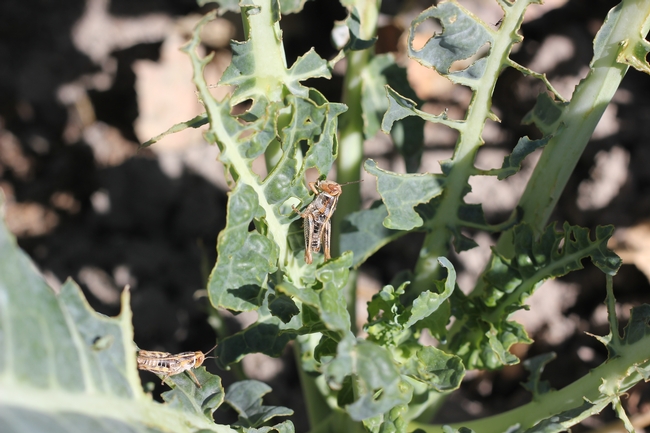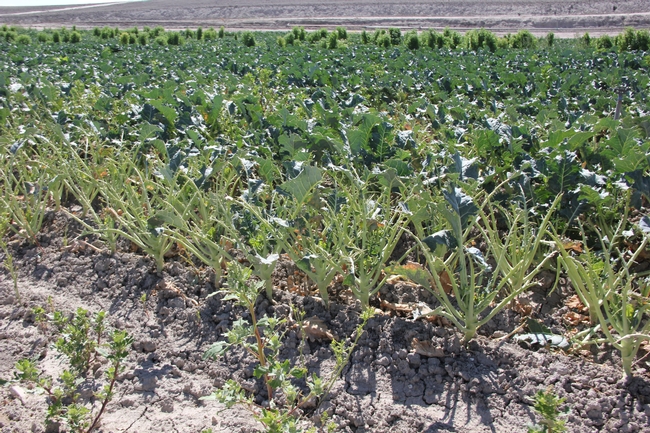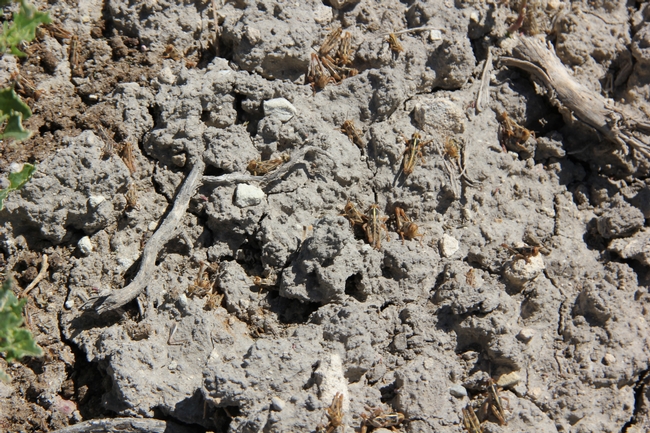Recently (mid April), a large number of grasshoppers has been found attacking broccoli and spinach crops in the southern parts of Salinas Valley (San Lucas, San Ardo etc). It is believed that these grasshopper populations were migrating from the dry grassland to leafy greens and Brassica crops. The feeding damage was typically found along the edge of the fields adjacent to the hills. Also, blister beetles (Epicauta spp.) were seen along with grasshoppers. Blister beetles were mostly feeding on the weed plants surrounding the fields. The feeding damage may not be critical but these insects may contaminate the harvested produce with dead or alive bodies and their excrement. The blister beetle adult is about an inch long, and blackish blue in color. Blister beetle has a distinct look that make them easy to identify from other beetles. The width of the neck is shorter than width of the head. The outer pair of fore wing is flimsy and not held tight on the abdomen.
Ecologically, both grasshopper and blister beetle interact with each other. The larval stages of blister beetle are predaceous and often prey on the eggs of grasshopper. Grasshopper lays eggs in a pod (120 eggs maximum) below the soil. The eggs hatch to first instar nymphs which molt through six nymphal stages before develop into adults. The nymphal stages are wingless but the late nymphal stages have wing pads (incomplete wings). Nymphal stages move only by jumping whereas adults can fly and jump. Most of the grasshoppers found in the fields are nymphs and they are found in aggregation feeding on the broccoli plants. It seems like they like broccoli than spinach. Grasshoppers are migratory in nature meaning they feed on what they find on their way and as the food resource depletes, they move on to another green patch.
Because of the greater size and high mobility, it is relatively difficult to kill these grasshoppers using insecticides. In the Salinas Valley, the wee and morning hours are cooler and grasshoppers are less active and remain in the ground waiting for the day to warms up. These early day time might be the best time for insecticide application but still, they might move away when the sprayer equipment approach them. Pyrethroid insecticides and acephate are effective but multiple applications might be warranted because grasshoppers are continuously moving in from the nearby dry grassland. Please check the label instructions before selecting the insecticide for grasshopper control. Management of grasshopper using organic insecticides will be a greater challenge than synthetic insecticides. Organically approved insecticides such as pyrethrum (Pyganic) might be the option. Because grasshoppers feed on plant material, spinosad (Entrust) might be effective too. Azadirachtin (Neem products) may provide some repellency. However, success is not guaranteed with any of these insecticides. There is a protozoan, Nosema locustae -- commercially available as a bait under the brand name Semaspore. The bran bait is mixed with spores and the spores enter their body while feeding. This bait is slow acting and success may vary. Physical barrier such as fencing between field and grassland might help but a spray on the barrier might check them from progressively moving into the field. Smaller production can use row covers to prevent their access to the crops. Managing grasshoppers in the grassland with approved insecticides might slow down the migration.



